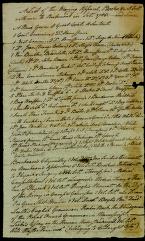|

Inventory of Charles Hart Ashley

A List of Wearing Apparel, Books, &c. of William Stoddard Williams

Inventory of Edward Allyn
|
Summary and Objective
Historians learn more about the past by investigating the sum of people's possessions. These posssessions include valuables like land, gold and jewelry, but also ordinary stuff like broken teapots, socks and garbage.
Inventories are organized lists that include everything in someone's possession. They complement the digging work of the archeologist. They provide evidence which is ready to use in responding to questions about our notions of what was available to a people, what was popular, and what was valued.
Similarly, we can 'investigate' the contents of our desks to practice making an inventory. Then, we can organize the list of stuff as historians do. Finally, we can analyze what we find to decide what is necessary and what is important to us. And, as a side benefit, we can help our students clean out the clutter!
Teaching Plan
Step 1.
Explain the activity. Provide students with a chart with six columns and six rows to organize their finds. Leave the headings blank, however.
Step 2.
Have students predict what they will find in their desks, and come up with categories as a group. Suggestions: textbooks, notebooks, writing utensils, other 'tools' i.e. calculators, and personal items. These will be their headings.
Step 3.
Have students take everything out of their desks. Prepare for a mess! Do not get the trash barrels out yet, however. Students should record every broken pencil, crumpled up paper, and food wrapper along with books etc.
Step 4.
Record each item in the proper category.
Step 5.
Collectively gather information: come up with lists of common items--everyone has a math book, for example. And look at the odds & ends--eight students have folders with a Harry Potter theme, for example. Discuss how these results answer our questions " What is necessary? What is popular? What is valued?"
Step 6.
Go to the American Centuries website, to the tagged items. Have students read the items, paying attention to personal items, technology, and the monetary value of items (if listed)
Step 7.
Identify some items that are familiar to students today, and others that are not, or are not important.
Step 8.
Returning to students' inventories, have them reflect in writing about how their possessions will be viewed by a future historian.
|




